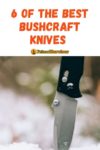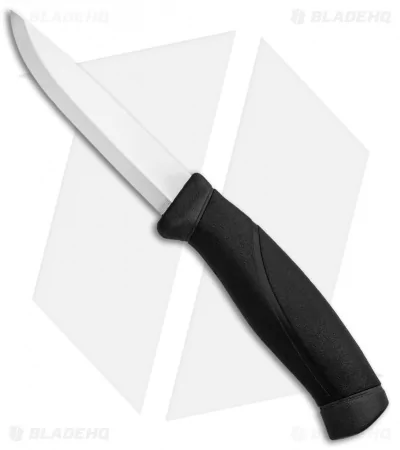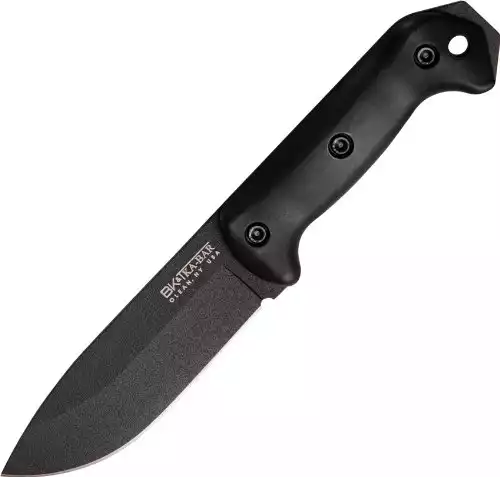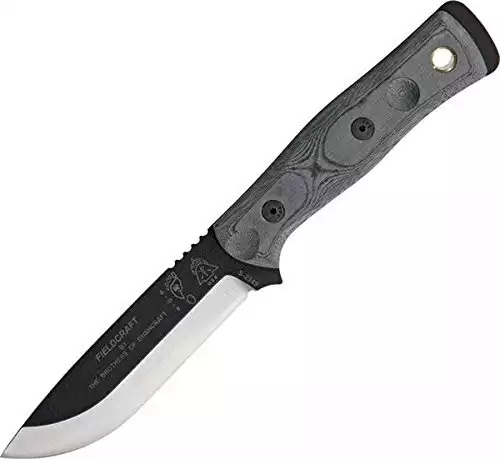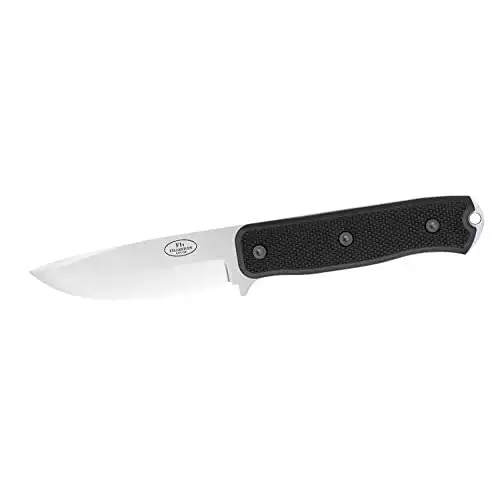Bushcraft knives prioritize function over flashy looks. Their design may seem deceptively simple, but if you find yourself in the wild when the SHTF, a bushcraft knife is the one blade you want to have by your side.
The good news is that plenty of great bushcraft knives are available at every price point. We wouldn’t hesitate to recommend any of the knives we’ve reviewed in this article, but to help you decide which knife to buy, we’ve summarized the pros and cons of each.
Our detailed guide to what to look for will also help you find the best bushcraft knife for you.
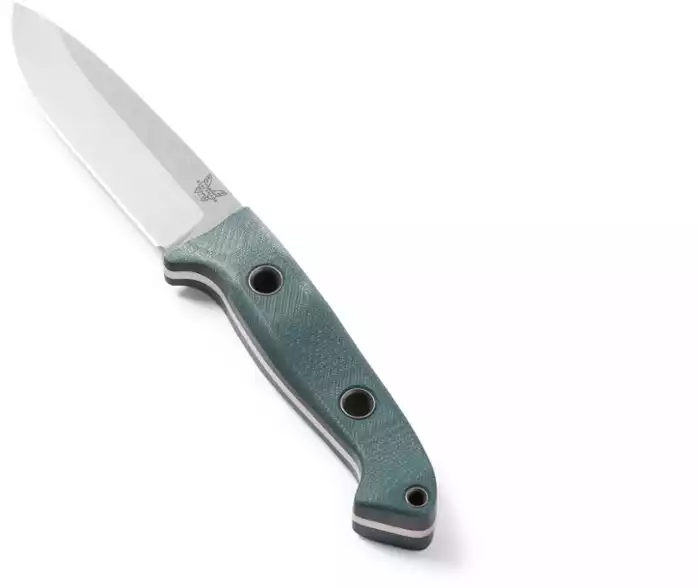 Benchmade – Bushcrafter 162
Benchmade – Bushcrafter 162
High-quality steel and a robust design set this premium knife apart from the rest.
Best Bushcraft Knife Reviews
Best All-Around Bushcraft Knife: Benchmade Bushcrafter 162
Blade length: 4.4 in | Total length: 9.2 in | Blade material: CPM-S30V | Weight: 7.7 oz
The Bushcrafter 162 embodies everything you want in a bushcraft knife: high-quality steel, a drop-point blade, and a comfortable handle. It’s a knife that will survive anything you put it through.
The 4.4-inch blade is small enough for whittling and food prep, and the full-tang design means you can baton wood for the fire without worrying about damaging the knife.
The main thing that sets the Bushcrafter 162 apart from other knives (and justifies its price tag) is the S30V steel used for the blade. Sometimes quoted as the “ultimate EDV steel,” it’s easy to sharpen, has excellent edge retention, and is resistant to corrosion.
Great for people who want a knife to get jobs done day after day after day.
It’s so robust that Benchmade offers a lifetime repair and sharpening service. That’s manufacturer confidence for you.
As you might expect, this kind of quality comes at a price. The Bushcrafter 162 is not a cheap knife. But it’s a worthy investment if you’re looking for a knife that will last you a lifetime and won’t let you down.
Pros
High-quality steel
Simple, effective design
Built to last forever
Lifetime guarantee
Made in the USA
Cons
Expensive
Sheath could be better
Best Budget Bushcraft Knife: Morakniv Companion
Blade length: 4 in | Total length: 8.6 in | Blade material: Sandvik 12C27 | Weight: 4.1 oz
A quality knife at this price? No, it’s not a joke. Made in Sweden, the Morakniv Companion is one of the most highly rated outdoor knives on the market.
It’s a light knife, weighing just over 4 ounces, with a 4-inch blade that is equally capable of cutting small tree limbs as finely filleting a fish. As it’s not a full tang knife, you may be cautious when using it for heavy-duty tasks, but you’ll be surprised at how well it stands up to rough use.
The blade is made from hardened Sandvik 12C27 stainless steel. This is popular budget steel that’s easy to sharpen.
The knife comes with a plastic sheath, which does the job but is nothing to shout about. Then again, you wouldn’t expect a top-quality sheath at this price.
Although we’ve rated this as the best budget knife, it would be considered one of the best bushcraft knives you could buy, even at twice the price.
Pros
Very sharp out of the box
Incredible value for money
Easy to sharpen
Lightweight
Cons
Not full tang
Budget steel
Best Heavy-Duty Knife: Ka-Bar Becker Campanion BK2
Blade length: 5.3 in | Total length: 10.8 in | Blade material: 1095 Cro-Van | Weight: 16 oz
The Ka-Bar BK2 toes the line between a bushcraft and survival knife with a longer-than-average 5.3-inch blade. It weighs in at a hefty pound with a thick edge that’s virtually indestructible.
For heavy-duty camp tasks such as shelter-building and chopping kindling, the BK2 comes into its own. It’s also an excellent hunting and general food preparation knife. Due to the weight, it wouldn’t be your first choice for a fighting knife (unless you have a slow opponent), and you may find it a bit too heavy and unwieldy for delicate woodwork tasks.
1095 Cro-Van steel is mid-range high-carbon steel that’s tough and easy to sharpen. The black plastic handle is rugged but can be slippery when wet. If you’re concerned, you can replace the handles with micarta handles to improve the grip, though this adds to the cost.
If you want a knife that’s a bit more robust than smaller bushcraft knives and don’t mind the extra weight, the Ka-Bar BK2 is an excellent choice.
Pros
Excels at heavy-duty tasks
Versatile
Easy to sharpen
Cons
Heavy
Poor grip when wet
Best Value: Morakniv Carbon Bushcraft
Blade length: 4.3 in | Total length: 9.3 in | Blade material: high carbon steel | Weight: 5.7 oz
The next step up from the Companion, the Morakniv Bushcraft knife, is just as versatile. It has a slightly longer blade which is also thicker, making it more suitable for more demanding tasks such as batoning.
The blade is made from high carbon steel (similar to 1095 steel, though Morakniv is coy about the actual makeup), making it more durable than the stainless steel used in the Companion. It has a black coating to protect the blade from corrosion, though it will likely wear over time, so you’ll need to use a knife oil to prevent rusting.
Another improvement is that the spine has been ground to a 90-degree angle, so you can easily use it with a firestarter. If you’re willing to shell out some extra bucks, you can buy an upgraded sheath with a fire starter and an integrated sharpener.
The handle is comfortable, with excellent grip and better ergonomics than the Companion. This is the knife to get if you’re looking for a great-value mid-range bushcraft knife.
Pros
Excellent value
Comfortable, ergonomic handle
Durable blade
Compatible with a firestarter
Cons
Blade susceptible to corrosion if coating wears off
Not full tang
Best for Fire Building: Tops Knives Brothers of Bushcraft Fieldcraft Knife
Blade length: 4.75 in | Total length: 10 in | Blade material: 1095 Steel | Weight: 9.6 oz
The Tops BOB Fieldcraft Knife is a great all-around bushcraft knife, but it has some additional features that make it particularly useful for fire building.
It has a full tang blade made from strong 1095 steel exposed at the pommel, so there’s no risk of damaging the handle if you hit the pommel when splitting wood. The pommel also features a scraper for striking Ferro rods (there’s an attachment point for one on the sheath), and there’s a bow drill divot on the handle for more primitive fire starting.
The blade is slightly longer and thicker than on other knives. This makes it great for chopping wood, but it’s not unwieldy and can be used for more delicate tasks. Remember that 1095 steel is more prone to rusting, so you’ll need to make sure you oil and take care of the blade.
The micarta handle is very comfortable and grippy, and the knife comes with a plastic sheath that is functional but nothing to shout about.
Pros
Full tang, durable blade
Comfortable, grippy handle
Scraper and bow drill divot for fire starting
Good for splitting wood
Cons
Blade susceptible to corrosion
Heavier than other knives
Best Craftsmanship: Fallkniven F1
Blade length: 3.8 in | Total length: 8.3 in | Blade material: VG-10 Steel | Weight: 6.4 oz
This is another bushcraft knife with a cult following, designed as a survival tool for the Swedish armed forces. Price-wise, it sits between the Bushcrafter 162 and Morakniv’s offerings. It’s great if you want a slightly shorter knife or have small hands.
The blade is made from laminated VG-10 steel, making it both strong and resistant to corrosion. The convex grind might take a little getting used to if you want a fine carving knife, but it is perfect for general bushcraft tasks.
As you might expect from a Swedish knife, the handle is designed for cold-weather use. Thermorun is a grippy rubber-thermoplastic combination that insulates your hand from the steel. The handle is on the thin side, so if you have huge hands, you may find it too small, particularly with gloves on, but for those with small or medium-sized hands, it’s perfect.
Perhaps most importantly, this knife is tough and reliable when it comes to survival.
Pros
Razor-sharp
Tough and reliable
Great for small-medium hands
Compact, lightweight knife
Cons
Handle a bit small for large hands
Pricey
Cheap sheath
What Do You Use a Bushcraft Knife For?
The easy answer to this is a bit of everything. From whittling wood to cutting small branches for shelter-building, gutting fish and game to food preparation, or making fires, if you only have one knife to survive in the wild, you want it to be this one.
Of course, no knife does it all (or at least not well), so the bushcraft knife does have a few limitations. It’s not explicitly designed as a self-defense tool (see here if you want the best self-defense knife), and in most cases, it’ll be too small for clearing large brush or branches. If you see bigger as better, you may want to get a quality survival knife instead.
The beauty of the bushcraft knife is that it hits the sweet spot between being small enough to carry easily and large enough to perform well across various tasks. They are also sturdy and well made – a prime consideration in a survival situation.
What to Look for in a Bushcraft Knife
It may be a jack-of-all-trades, but your criteria when shopping for a bushcraft knife is quite specific.
Knife Style and Durability
A bushcraft knife is a workhorse. Unlike a boot knife, for example, which is unlikely to get frequent use, you’ll be using your bushcraft knife every day when you’re in the wild. This makes durability a prime consideration.
For this reason, most bushcraft knives are full tang fixed-blade knives. This is the most robust knife design, as the steel runs the entire length of the handle.
It’s also worth considering the thickness of the blade. Cheaper, less durable blades are typically thinner. This makes them lighter but more prone to breakage.
Finally, look at the quality and durability of the handle. You want something that won’t be easily damaged or affected by water. The size of handle you go for depends on personal preference and the size of your hands.
Blade Length
One of the significant differences between a bushcraft knife and a survival knife is the blade length. Whereas survival knives are designed to be a big, blunt-force tool, bushcraft knives are designed for more delicate work.
The ideal blade length for a bushcraft knife is around four inches. Small enough for whittling but large enough to prepare firewood.
Blade Shape
The most common blade shape for a bushcraft knife is a drop point. The convex curve from the spine to the blade’s tip makes it durable and versatile, and the large, curved belly is perfect for slicing and whittling.
Bushcraft knives are not typically serrated, as the portion of the blade nearest the handle is the section you’re most likely to need for delicate tasks.
Blade Steel
The steel used is a big determiner of knife quality. While your budget will play a part in your decision, if there’s one knife you’re going to splash out on, a bushcraft knife should be top of your list. Think of it as the knife you want to pass down to your grandkids.
Sharpness is essential, but for this knife, ease of sharpening should also be a high priority. It’s going to get a lot of use, and the easier it is to keep a razor edge, the more likely you are to keep it sharp.
If you’re unsure, check out our guide to the best knife sharpener.
High carbon steel is a popular choice due to its ability to hold an edge, but it is less resistant to corrosion than stainless steel. For this reason, most high-carbon steel knives have a special coating to resist corrosion.
Knife Handle
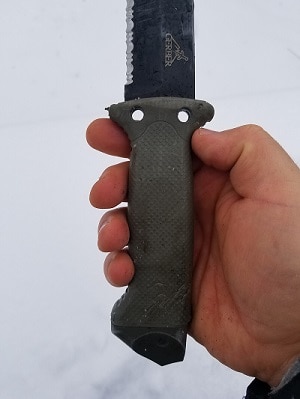
Traditionally (in the days before modern factory production), bushcraft knives had wooden handles, and many manufacturers continue this trend today. Wood feels warm against your skin and when properly treated, should be as hygienic and water-resistant as plastic.
Plastic or rubber handles tend to offer a better grip than wood. If you’re less experienced using a knife, you may find these an easier and safer option. Cheap plastic handles can be brittle or less durable, but those from reputable manufacturers use high-quality materials.
Sheath
When buying a knife, you may not consider the sheath, but it’s not something to overlook. A good sheath will be durable, hold your knife securely (but not make it impossible to remove), and have different options for securing it to you or your bag.
If you’re unhappy with the sheath your knife comes with, you can replace it with a custom-made one or make your own. Ideally, though, the sheath should be part of your decision-making when choosing a knife.
